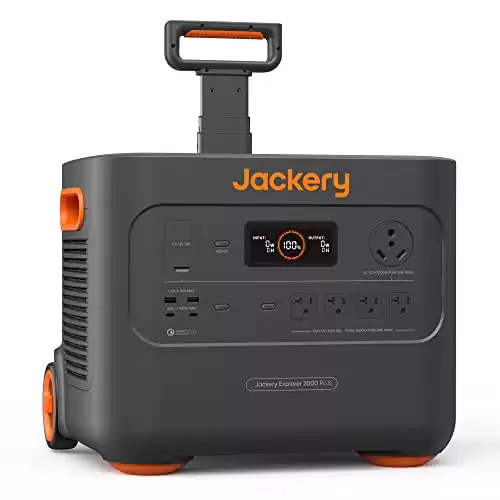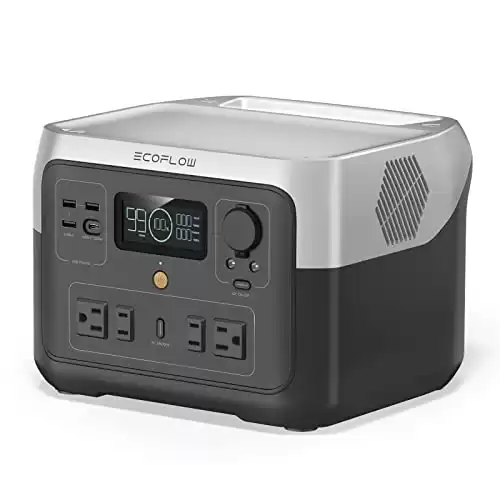Jackery is a prominent brand in the power station and solar generator industry. However, with the recent shift to LiFePO4 batteries, it’s important to understand the type of battery in a Jackery.
Is Jackery a LiFePO4 Battery?
Most Jackery power stations are not LiFePO4.
Jackery uses NMC battery chemistry (more on that below).
As of July 2023, the only Jackery LiFePO4 power station is the Jackery 2000 Plus.
(note: some links in here are affiliate links where I earn money if you buy any product. It helps keep display ads off this site!)
However, the most popular size for Jackery is the Jackery 500 which is not LiFePO4.
You can read my full list of the best LiFePO4 power stations here.
What Kind of Battery is a Jackery?
Most Jackery power stations are Nickel Manganese Cobalt Oxide (NMC). In the past, these were much cheaper to produce, and many popular brands opted for this type of battery.
In addition, because the energy density is higher, they were lighter than a comparable LiFePO4.
Those were the two key selling points for choosing NMC batteries for outdoor folks.
However, as power stations became larger and larger, and the investment lager and larger, people started noticing the benefits of LiFePO4 batteries. Primarily the longer product life, better safety ratings, and comparable prices.
| Features | NMC Batteries | LiFePO4 Batteries |
|---|---|---|
| Energy Density | High (lighter weight for a given energy capacity) | Moderate (heavier due to lower energy density) |
| Cycle Life to ~80% capacity | 500-1,000 cycles (capacity drops to ~80% after this many charge/discharge cycles) | 2,000-3,000 cycles (some sources claim up to 5,000; capacity drops to ~80% after this many cycles) |
| Safety | Good (safe under normal conditions, but risk increases if damaged or misused) | Excellent (inherently safer due to chemical stability, even under stress) |
| Temperature Tolerance | Moderate (performance may decrease in extreme temperatures) | Excellent (maintains performance even in extreme temperatures) |
| Cost | Moderate to High (due to cost of materials and manufacturing process) | High, but decreasing quickly (as technology matures and economies of scale kick in) |
| Environmental Impact | Moderate (manufacturing process and materials extraction has an environmental impact) | Lower (longer lifespan and more common materials reduce environmental impact) |
| Applications | Commonly used in EVs, electronics, and power tools due to its high energy density | Preferred for EVs, backup power supplies, and solar power storage due to its safety and longevity |
Read my full article on LiFePO4 vs NMC batteries.
For some reason, Jackery even used NMC technology in the Jackery 3000, a ~$3,000 purchase while their competitors like EcoFlow LiFePO4, Anker, and Bluetti made similar-sized power stations with LiFePO4.
Read the best Jackery Alternatives.
When a power station is 50lbs+, weight is not what you should be prioritizing since you aren’t moving them long distances. Thus, LiFePO4 is the way to go for anything above a 500Wh power station (in my opinion.
Jackery Jumps into LiFePO4 with the Jackery 2000 Plus
I believe Jackery will continue to transition its products to LiFePO4 as it’s a primary reason consumers choose other brands.
As we navigate the ever-evolving landscape of portable power solutions, we are poised to witness a continued shift toward more efficient and sustainable battery technologies. LiFePO4, with its robust lifespan, excellent safety features, and increasingly competitive pricing, is set to play a major role in the future of this industry.
A significant factor driving this trend is the maturation of LiFePO4 technology. As manufacturing processes become more refined and economies of scale come into play, the cost of LiFePO4 batteries is expected to decrease further. This positions LiFePO4 as a more accessible option for manufacturers and consumers alike.
But the future isn’t limited to LiFePO4. Emerging technologies such as solid-state lithium batteries and next-generation lithium-sulfur batteries are making waves in the energy sector. These promise even higher energy densities and safer operation, which could revolutionize the way we think about portable power.
The key takeaway is that brands like Jackery must continue to innovate and adapt in this fast-paced industry.
Whether that means a broader adoption of LiFePO4 or an investment in next-gen battery technologies remains to be seen.
Continue reading:



